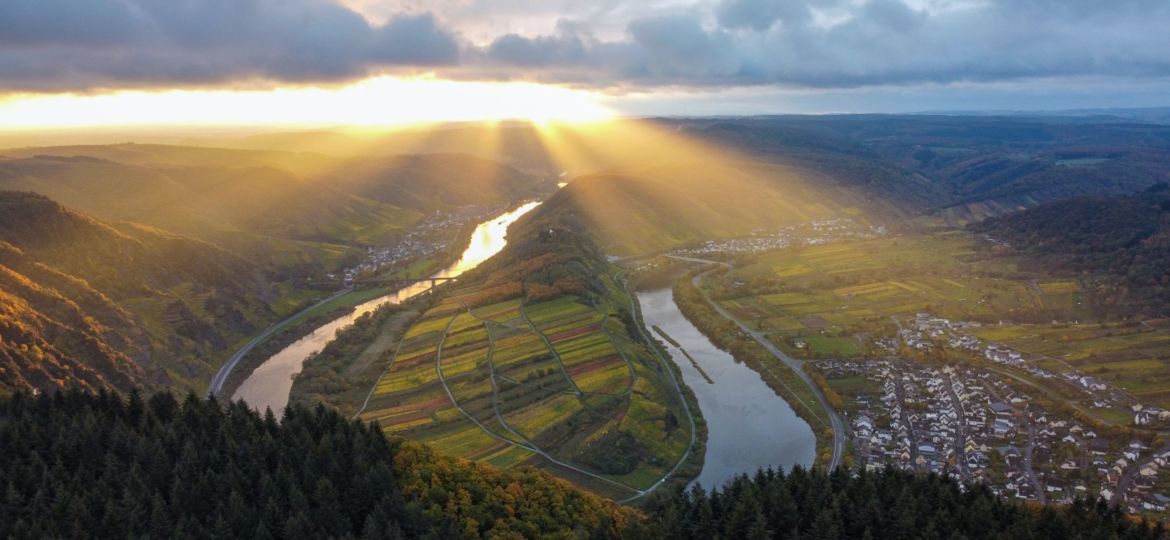
Riesling is often misunderstood. For people not familiar with the it, first thoughts are of sweet syrupy wines. On the other extreme, Riesling from Australia can get a reputation of smelling and tasting like a just opened tube of tennis balls (really).
German Riesling is made in many different styles ranging from very dry to cloyingly sweet.
Riesling in the Kabbinett style is typically sweeter than your standard dry white wine but very restrained. The higher acidity and lower alcohol helps them to be enjoyable with a variety of foods and not viewed as anything close to a dessert wine.
Great Wines
Dr. Loosen is located in the Mosel region of Germany where some of the finest Riesling’s are produced. The winery has been around for over 200 years and is family owned to this day. Currently run by Erni Loosen, before taking the reins, Erni spent time at the greatest European wine estates to truly understand what makes a wine great. He brought those observations back to the winery and the results are stunning.
The vineyard sites help with quality, as well. Dr. Loosen holds some of the finest “Grand Cru” sites in Germany. One of those sites is the Sonnenuhr vineyard. This extremely steep site is covered in blue slate and there is barely any top soil to be found. This is great for grapes as the more the vines struggle, the better the fruit.

This Mosel Riesling is a very pale lemon in the glass. The smells of lemon, peach, honeysuckle, petrol, vanilla, grapefruit peel, and pineapple bounce out of the glass. While the high acidity was no surprise, the sturdy medium body of this wine added a nice element.
The palate tasted of tart lemons, white peaches, and key lime pie. The finish was long and pleasant. This is a great wine with plenty of room for a little more aging but you can absolutely enjoy it now (and should).
- Vintage: 2019
- Varietal: Riesling
- Appellation: Mosel
- Great for:
Instead of beer, Spicy Indian food

August Kesseler understands that the wine begins in the vineyard. This German winery takes pride in what they grow on their almost 80 acres of vineyards. These grapes are located on steep slopes above the Rhine River in the Rheingau region. August Kesseler. During the summer, you can reach their winery by chair lift floating above the vineyards.
Focused only on Pinot Noir and Riesling this gives August Kesseler space to hone their craft on these iconic varietals. Wine production is separated by vineyard site which means they have a full palette available for painting a masterful blend. This is a winery with high standards and these come through in every bottle opened.
This wine is a beautiful pale gold. The smells are of a rich Riesling full of ripe apples, peaches, nectarines, and honey. The gentle acidity and touch of sweetness further add to the ripeness of the stone fruits on the palate.
This is a light bodied off-dry wine that goes well with many dishes but was a real treat with a quiche.
- Vintage: 2020
- Varietal: Riesling
- Appellation: Rheingau
- Great for:
Quiche, After work
We can’t review Kabinett Riesling without including the winery where the style was literally invented. The Kabinett style was created at this winery in 1716. For this reason, the Kabinett is the signature style at Schloss Vollrads.
After the tragic death of the vintner in the 1990s, the estate has been owned by a bank since then. The main structure looks like it came straight from a fairy tale. While the site is over 800 years old, they have embraced the modern by adding solar panels for sustainability.
The site is excellent for grape growing in Germany as the nearly 200 acres of vines all slope down to the Rhine River on south facing hills.

As expected for a German Riesling, this poured a bright pale lemon into the glass. The intense aromas of lemon, lime, peaches, honeysuckle, and petrol rose up out of the glass. This one, however, presented with a more unique dominant aroma of a lemon lime powdered drink which was unexpected but awesome.
The medium sweetness was balanced by the acidity in the wine and the lower alcohol. The flavors of candied lemon peel, pineapple, peaches, and petrol lingered on the palate.
- Vintage: 2019
- Varietal: Riesling
- Appellation: Rheingau
- Great for:
Chinese takeout

The Maximin Grunhauser winery has some very deep roots that go back to the time of Charlemagne. This winery has been owned by the von Schubert family since 1882 and is now in the 6th generation. Before that, the site was an abbey that has made wine since at least 966.
The winery uses wild yeast to maximize terroir which is an important goal for the winemaker. They also use oak barrels made from forests that are near the winery.
The Herrenberg vineyard is an almost 50 acre site. The soil is dominated by blue slate. This is important as the stones help heat the ground and retain the warmth from the sun. This extra heat helps the grapes to ripen more fully and develop better flavors.
The site borders a forest along one end which helps to keep the area from getting too hot in the summer and also protects from wind.
A pale yellow lemon in the glass, the greets with a soft nose of white peach, lemon, hay, pineapple, and honeysuckle. The palate is full of classic Riesling flavors of peaches, pineapples, candied citrus peel, and hay.
The acidity is not too high and the wine is medium dry which provides just the right amount of sweetness. The finish is long and enjoyable on this wine.
- Vintage: 2020
- Varietal: Riesling
- Appellation: Mosel
- Great for:
Crisp, roasted chicken



